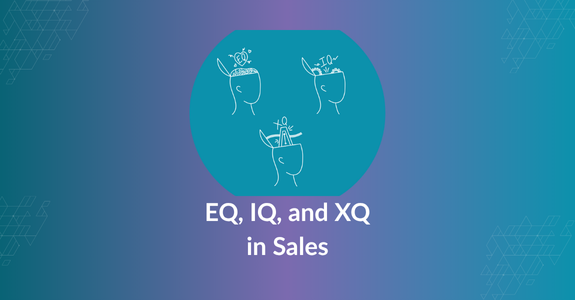EQ, IQ and XQ in Sales: What’s the Difference and Why Do They Matter?
by Mentor Group

Introduction
Modern selling demands more than product knowledge. Buyers expect relevance, speed and low risk; sellers need human connection, clear judgement and the discipline to execute. That is why high‑performing teams develop three dimensions of capability: EQ (how to sell to humans), IQ (insight‑driven judgement), and XQ (Execution Quotient: doing the right things, to the right standard, at the right cadence). When you balance all three, training stops being an event and starts moving the numbers.
For a full breakdown of what it takes to utilise EQ, IQ, and XQ in sales training programmes, read our pillar blog.
What Are EQ, IQ and XQ?
- EQ (Emotional Intelligence) — awareness of self and others, empathy, rapport, and the ability to build trust and relevance in every interaction.
- IQ (Commercial/Insight Intelligence) — the ability to interpret data and context, link value to outcomes, qualify rigorously and make sound decisions.
- XQ (Execution Quotient) — the consistency and quality of sales behaviours in the workflow: preparation, discovery depth, multithreading, next‑step hygiene and follow‑through.
Together, they describe competence you can trust: EQ builds access, IQ creates conviction, and XQ makes progress predictable.
Why They Matter (and How They Show Up in Results)
EQ, IQ and XQ map cleanly to outcomes leaders care about. Use the 3V lens:
- Value — EQ earns senior access; IQ frames business impact; XQ maintains pricing discipline.
- Volume — EQ improves response and referrals; IQ targets the right accounts; XQ keeps opportunities moving.
- Velocity — EQ reduces friction; IQ anticipates risks; XQ drives crisp next steps and cycle‑time reduction.
The result is cleaner coverage, better win‑rates and reliable forecasting — without adding noise to the tech stack or hours to the calendar.
How to Assess EQ, IQ and XQ (Without a Six‑Month Study)
- Define the few critical behaviours for your go‑to‑market (e.g., discovery depth, stakeholder mapping, proposal clarity).
- Collect light‑touch evidence: call snippets, opportunity notes, practice clips, proposals. Score for quality, not volume.
- Triangulate with outcomes: look for links between behaviours and 3V metrics (conversion, margin, cycle time).
- Run a short diagnostic: name the top three gaps; set success criteria you can report to the board.
Keep it practical: the aim is useful insight in weeks, not a perfect report in months.
Design Training That Balances EQ, IQ and XQ
Great programmes move beyond content to practice and execution. Use the Learn → Practise → Embed loop:
- Learn — concise, contextual modules that reflect your buyers, stages and language.
- Practise — scenario‑based digital practice (AI role‑plays, simulations) with objective feedback and re‑tries.
- Embed — a weekly manager coaching cadence, prompts in the tools sellers already use, and a visible XQ scorecard.
Map each module to one or two observable behaviours, then instrument them so you can show behaviour → 3V movement.
Where Technology Helps (and Where It Hurts)
- Helps: AI role‑plays for safe repetition; bite‑size simulations for complex conversations; digital experts surfacing prompts in Teams/Slack/CRM; proposal quality assistants.
- Hurts: tool sprawl, portals outside the flow of work, and any system that adds admin with no coaching value.
Adoption improves when data privacy and security are clear from the start (ISO‑aligned controls, SSO and configurable retention). Keep everything your way, not our way — aligned to your methodology and governance.
Common Mistakes to Avoid
- Over‑indexing on product knowledge and skipping human skills.
- Measuring attendance, not behaviour.
- Training without practice; practice without coaching.
- Buying platforms before defining the behaviours you want to see.
Measuring Progress the Board Will Believe
Tie your reporting to the language of the business:
- Behavioural telemetry — evidence that EQ/IQ/XQ standards are met in live opportunities.
- 3V movement — stage conversion, margin, multithreading, cycle time, and reduction in no‑decision.
- Manager cadence health — coaching completion and quality signals, not just activity counts.
Publish a before/after for pilots and scale what works.
Bottom Line
Q1. What is EQ in sales?
A1. EQ is emotional intelligence in a selling context — the ability to understand yourself and others, build trust quickly and maintain relevance in every interaction.
Q2. What is IQ in sales?
A2. IQ is commercial and insight intelligence — connecting data and context to diagnose problems, qualify rigorously and link your solution to business outcomes.
Q3. What is XQ and how is it different?
A3. XQ is Execution Quotient — the consistency and quality of sales behaviours in the workflow. It’s different because it measures doing, not just knowing.
Q4. How do we measure EQ, IQ and XQ?
A4. Define a few critical behaviours, collect light‑touch evidence (calls, notes, practice clips, proposals), score for quality and link to 3V outcomes like conversion, margin and cycle time.
Q5. How do we improve XQ?
A5. Use Learn → Practise → Embed with weekly manager coaching, objective feedback from digital practice, and clear standards for preparation, discovery, next steps and multithreading.
Q6. Do AI role‑plays really help?
A6. Yes — they allow safe, repeatable practice with instant feedback so sellers can make mistakes privately, improve quickly and hit a consistent standard before customer calls.
Q7. How much time should training take?
A7. Short, frequent reps beat marathons: micro‑learning and practice loops over weeks with embedded coaching, rather than one‑off all‑day sessions.
Q8. What’s the manager’s role?
A8. Managers are the multiplier: they run the weekly coaching cadence, review evidence and keep the team focused on the few behaviours that move 3V outcomes.
